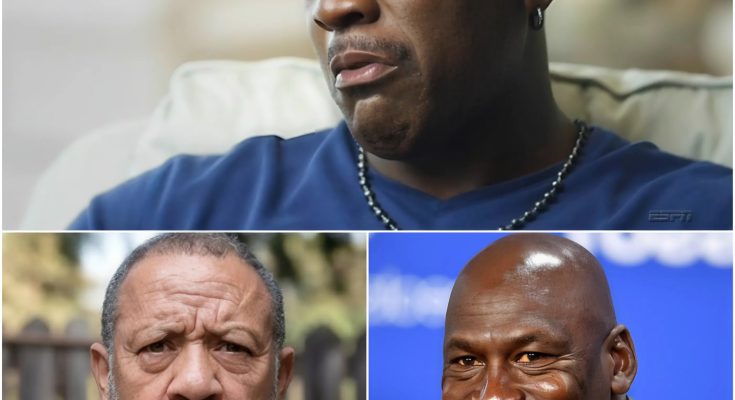Michael Jordan Finds Out His Former Teammate is Living on the Streets – His Response Will Move You
Michael Jordan Finds Out His Former Teammate is Living on the Streets – His Response Will Move You

It was a quiet evening in Chicago, and Michael Jordan was preparing for another game in the spotlight, when an unexpected phone call changed everything. The voice on the other end of the line was from an old friend, a former teammate from his early years in the NBA. The news was as shocking as it was heartbreaking: his former teammate, someone who had shared countless moments of triumph on the court, was now living on the streets, struggling to survive.
Jordan, who had experienced the highs of fame and fortune, never imagined that one of his own would fall so far. He listened in disbelief as the friend explained the dire situation—how life had spiraled out of control for his former teammate after retirement. A combination of personal struggles, financial mismanagement, and the lack of a strong support system had left him without a home, nowhere to turn.
Without hesitation, Michael made a decision. He knew this was not just a call for help—it was a reminder that no matter how successful you are, the world can still be unforgiving.
As a basketball legend, Michael Jordan was used to handling pressure, but this was different. This was personal.
A Search for Answers
The next day, Michael Jordan did something he had rarely done before—he left the safety of his luxurious home and stepped into the streets of Chicago to find his old friend. He didn’t send a car or arrange for an assistant to do the legwork. Instead, he drove himself, making his way through the neighborhoods he once knew well, asking around, hoping to track down someone who had once been a star in his own right.
The journey wasn’t easy. For hours, Michael spoke to strangers, visited shelters, and even talked to people who had no idea who he was. But he was determined. He had made a promise to himself and to his former teammate that he would help him rebuild his life, no matter how tough the road ahead might be.
Finally, after hours of searching, Michael found him. His former teammate was sitting in a park, looking worn and weary, his clothes tattered, and his eyes dull. When he saw Michael approach, there was a brief flicker of recognition—followed by disbelief.

“You?” he asked, his voice shaky. “What are you doing here, Mike?”
Jordan knelt down beside him, offering a hand. “I heard about what’s been going on,” he said softly. “And I couldn’t just sit by and do nothing.”
The Reconnection
The two men sat there for hours, talking. They spoke about their shared memories—on and off the court—and the decisions that led to where they were now. Michael didn’t judge him. Instead, he listened, offering encouragement, just as he would have when they were teammates, sharing the same dreams.
Jordan’s heart ached as he learned about the struggles his former teammate had faced in the years after their time together in the league. The loneliness, the pain, the feeling of being forgotten by the world they had once conquered together—it all came rushing back.
But for Michael, this was more than just an act of charity. It was a commitment to a friend who had once been by his side during some of the toughest games of his career. Michael wasn’t just going to offer a handout; he was offering a lifeline.
“You’re not alone in this,” Michael said, his voice filled with conviction. “We all fall sometimes, but it’s not about how many times you fall—it’s about how you get back up. And I’m here to help you stand tall again.”
The Road to Recovery
In the weeks that followed, Michael took immediate action. He made sure his former teammate received medical attention and found a place to stay. He worked with financial advisors to help him regain control over his life and personal affairs. Michael’s first priority was to get him back on his feet, but more than that, he wanted him to know he wasn’t forgotten.
As the days turned into weeks, the transformation was undeniable. The man who once wandered the streets, struggling to find meaning in a world that had passed him by, began to regain his confidence. He started attending therapy sessions, rebuilding his skills, and slowly re-entering the workforce. The fire that had once driven him to success was rekindled.
Michael didn’t let him fall back into his old habits. He checked in daily, offering guidance, support, and, when necessary, tough love. Michael had seen what it took to be a champion—both on the court and in life—and he knew that this was a challenge that required a team effort.
A Full Circle
Months later, Michael stood in front of a crowd at a charity event, and as he gave a speech about the importance of community, support, and second chances, he glanced at the man sitting in the front row. He was no longer the same person who had once been lost in the streets; he was standing tall, proud, and ready to rebuild his life.
“Basketball taught me a lot,” Michael said, his voice steady. “It taught me about winning, losing, and everything in between. But what it didn’t teach me was how to help a friend when they fall. Sometimes, it’s not about the game. Sometimes, it’s about being there for someone when they need you most.”

The crowd stood in silence, their eyes filled with admiration. Michael wasn’t just talking about basketball—he was talking about life. And in that moment, it was clear that his former teammate had found more than just a second chance; he had found a new path, one that was paved with hope, determination, and the unwavering support of a friend.
Michael Jordan had done more than just save a career—he had saved a life. And in doing so, he had reminded us all that true greatness isn’t defined by titles or records, but by the impact we make on the lives of others.



